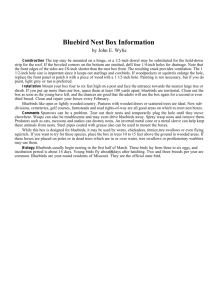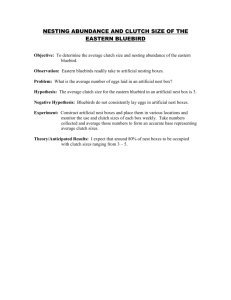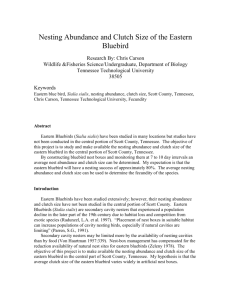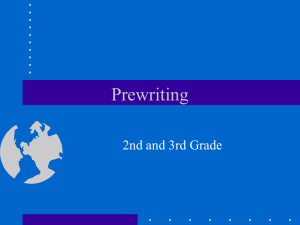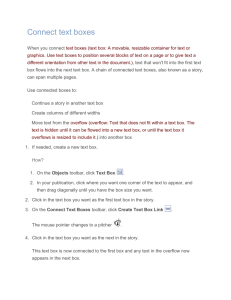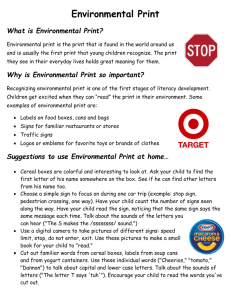bluebird handout
advertisement
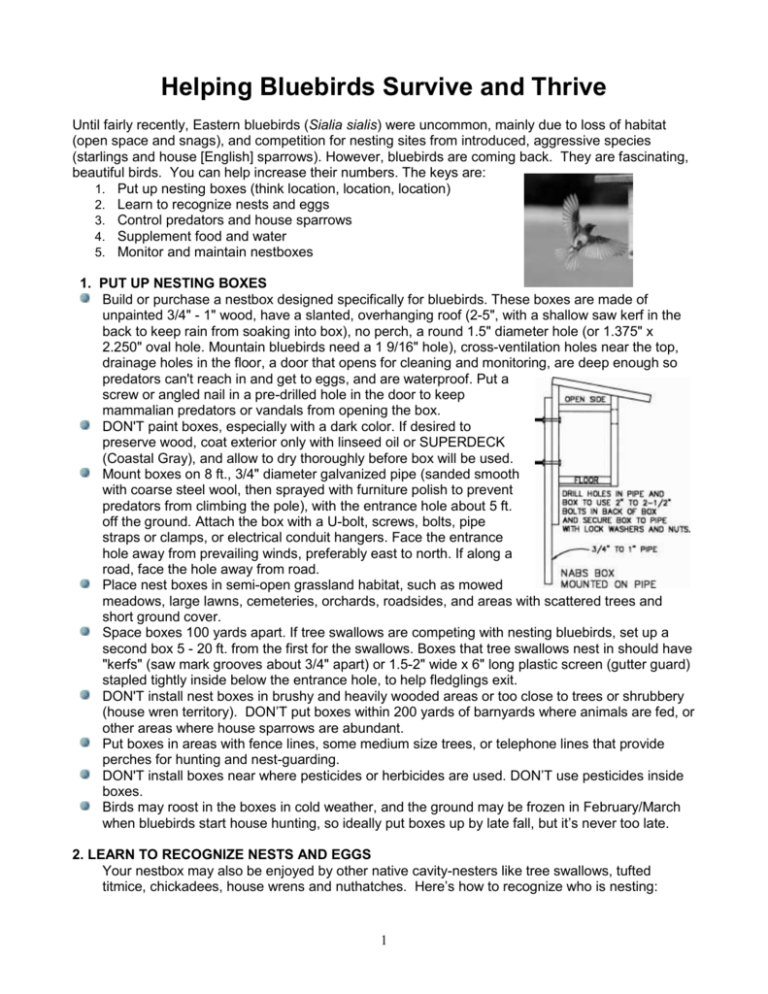
Helping Bluebirds Survive and Thrive Until fairly recently, Eastern bluebirds (Sialia sialis) were uncommon, mainly due to loss of habitat (open space and snags), and competition for nesting sites from introduced, aggressive species (starlings and house [English] sparrows). However, bluebirds are coming back. They are fascinating, beautiful birds. You can help increase their numbers. The keys are: 1. Put up nesting boxes (think location, location, location) 2. Learn to recognize nests and eggs 3. Control predators and house sparrows 4. Supplement food and water 5. Monitor and maintain nestboxes 1. PUT UP NESTING BOXES Build or purchase a nestbox designed specifically for bluebirds. These boxes are made of unpainted 3/4" - 1" wood, have a slanted, overhanging roof (2-5", with a shallow saw kerf in the back to keep rain from soaking into box), no perch, a round 1.5" diameter hole (or 1.375" x 2.250" oval hole. Mountain bluebirds need a 1 9/16" hole), cross-ventilation holes near the top, drainage holes in the floor, a door that opens for cleaning and monitoring, are deep enough so predators can't reach in and get to eggs, and are waterproof. Put a screw or angled nail in a pre-drilled hole in the door to keep mammalian predators or vandals from opening the box. DON'T paint boxes, especially with a dark color. If desired to preserve wood, coat exterior only with linseed oil or SUPERDECK (Coastal Gray), and allow to dry thoroughly before box will be used. Mount boxes on 8 ft., 3/4" diameter galvanized pipe (sanded smooth with coarse steel wool, then sprayed with furniture polish to prevent predators from climbing the pole), with the entrance hole about 5 ft. off the ground. Attach the box with a U-bolt, screws, bolts, pipe straps or clamps, or electrical conduit hangers. Face the entrance hole away from prevailing winds, preferably east to north. If along a road, face the hole away from road. Place nest boxes in semi-open grassland habitat, such as mowed meadows, large lawns, cemeteries, orchards, roadsides, and areas with scattered trees and short ground cover. Space boxes 100 yards apart. If tree swallows are competing with nesting bluebirds, set up a second box 5 - 20 ft. from the first for the swallows. Boxes that tree swallows nest in should have "kerfs" (saw mark grooves about 3/4" apart) or 1.5-2" wide x 6" long plastic screen (gutter guard) stapled tightly inside below the entrance hole, to help fledglings exit. DON'T install nest boxes in brushy and heavily wooded areas or too close to trees or shrubbery (house wren territory). DON’T put boxes within 200 yards of barnyards where animals are fed, or other areas where house sparrows are abundant. Put boxes in areas with fence lines, some medium size trees, or telephone lines that provide perches for hunting and nest-guarding. DON'T install boxes near where pesticides or herbicides are used. DON’T use pesticides inside boxes. Birds may roost in the boxes in cold weather, and the ground may be frozen in February/March when bluebirds start house hunting, so ideally put boxes up by late fall, but it’s never too late. 2. LEARN TO RECOGNIZE NESTS AND EGGS Your nestbox may also be enjoyed by other native cavity-nesters like tree swallows, tufted titmice, chickadees, house wrens and nuthatches. Here’s how to recognize who is nesting: 1 Bluebird: Neat, woven nest of 100% fine grass or pine needles, with a fairly deep nest cup. Occasionally bits of fur or a few feathers. Eggs are powder blue, sometimes white. House sparrow: Tall, often messy nest with tunnel like entrance. Jumble of odds and ends, including coarse grass with seed heads, cloth, white feathers, twigs and sometimes litter. Eggs are cream/white/gray or greenish with many irregular brown speckles. Black-capped chickadee: Downy nest of moss, fur, and soft plant fibers. Female may cover eggs with moss when leaving the box. Small white eggs with brown/rose speckles. Tufted titmouse: Downy nest of moss, fur, and soft plant fibers. Eggs are tiny, white with rose/mauve speckles. House wren: Messy nest of twigs, occasionally lined with fine fibers or feathers. Males may build loose, egg-less “dummy nests” in nearby boxes to reduce competition. Tiny glossy white eggs tinted pink/buff, with lots of fine brown/reddish brown/brown specks that are sometimes concentrated in a ring on the larger end of the egg. 3. CONTROL PREDATORS AND HOUSE SPARROWS DON'T mount boxes on trees or fence lines which provide easy access for predators. (Note: Titmice may prefer boxes mounted on trees.) Install predator guards to keep predators like snakes and raccoons from raiding nests, even if you don’t have problems the first year of nesting. You can use a 2-4 ft. long, 8" diameter stovepipe or PVC pipe sleeve on the pole, mounted (so it wobbles) just under the box (see drawing on page 4), or sand metal with coarse steel wool and then spray the pole annually with furniture polish or silicone. If squirrels chew the entrance hole to widen it, screw a metal hole guard (available from birding stores) or a 1.5" thick block of hardwood with a 1.5" entrance hole over the damaged hole, or replace the front part of the box. DON'T hesitate to destroy house sparrow nests and eggs. House sparrows are non-native invasive pests, and are not protected by law. You might think they're cute (some bluebirders refer to them as "rats with wings"), but they will attack and kill adult bluebirds (sometimes trapping them in the nest box), and destroy eggs and young. House sparrow nests, eggs, young, and adults may be legally removed, trapped, or destroyed. It is better to have no box at all than to allow house sparrows to reproduce in one. Try attaching strands of 10 lb. fishing line to boxes before nesting season starts to scare house sparrows. Sparrow spookers using shiny Mylar are also effective. (See drawings on page 4 or www.sialis.org/hosp.htm.) Neither bothers native birds. DON'T feed corn, bread, milo, or millet in bird feeders, as this attracts house sparrows. Stick with black sunflower seed, thistle (nyjer) and fruit. Plug up decorative nestboxes, remove the floor, or put on a hole reducer (1 1/8” or smaller) to prevent use by house sparrows. DON'T remove tree swallow, tufted titmouse, or chickadee nests. It’s illegal to disturb a nest with eggs of any bird except house sparrows, starlings and pigeons, which are not protected. DON’T put boxes in house wren habitat (near brambles/shrubbery/woods). Empty house wren nests can be removed. If allowed, these aggressive birds may fill every box in their territory with sticks, making them unavailable, and may also pierce and remove eggs and kill young nestlings. 4. SUPPLEMENT FOOD AND WATER About 68% of a bluebirds' diet is made up of insects: grasshoppers, crickets, beetles, spiders, and caterpillars. They also like wild berries such as dogwood (Flowering, Pagoda, Kousa), holly, eastern red cedar, mulberry, wild grape, Virginia creeper, and viburnum. Although they will eat the fruit of multiflora rose and Japanese honeysuckle, these are invasive species, and should be eradicated. Plant native trees, shrubs, and vines that provide fall and winter food. Bluebirds may eat specially formulated suet (see www.sialis.org/suet.htm for recipes). They rarely eat birdseed, although they may occasionally take sunflower chips. 2 Bluebirds love mealworms, and offering them may convince bluebirds to stay in your area and nest. Mealworms can be purchased by mail order. Provide fresh water in a bath no more than 3" deep, with gently sloping sides, and a rough surface to provide good footing. 5. MONITOR AND MAINTAIN If you are unwilling or unable to monitor boxes, and prevent house sparrows from nesting, it's better not to put up a box. Monitor boxes at least once a week to check on progress and control house sparrows, blowflies, etc. DON'T monitor more often than twice a week, or in early morning/evening or during bad weather. DON'T worry that monitoring will make the parents desert the nest. Bluebirds tolerate human presence. Touching the nest will not make the birds leave. Most songbirds don't have a good sense of smell. (Do be cautious when monitoring chickadee nests as they are more easily disturbed by frequent box opening.) DON'T touch eggs while monitoring. Some, especially chickadee eggs, are very fragile. Remove eggs that have not hatched 4 days after last egg hatched. Remove any dead birds immediately. DON'T assume the nest is abandoned. During egg laying, adults may spend very little time in the box. On hot days, the female may leave the nest for long periods of time. The only sure way to know the nest is abandoned is if neither parent has visited the nest for four full hours after the young have hatched. If it has been abandoned, contact a licensed wildlife rehabilitator, the Audubon Society or the North American Bluebird Society. DON'T open the boxes once the birds are 12-14 days old. (Parents may just dip their heads into the box hole to feed young at this age. The nestlings’ eyes are fully open when they are 8-11 days old.) It can cause young to fall or hop out of the nest box before they are capable of flying, reducing their chances for survival. House wrens are especially prone to premature fledging. Bluebirds like a clean box. Remove bluebird nests as soon as the young fledge, or if nesting fails, to encourage another brood and prevent parasite/disease problems. Put nests in the trash to avoid attracting predators. If mice nest in the boxes over the winter, clean boxes out in February. Replace any split, rotten, or broken pieces on boxes that could let rain in and chill nestlings. DON'T get discouraged if bluebirds don't nest in your boxes the first year. Be patient – it is worth the wait. And be prepared to become possessed by these captivating birds. BLUEBIRD TIMETABLE Bluebirds may raise 2-3 broods in one season. Some studies have shown that about 30% of adult bluebirds return to previous nesting sites the following season. House Hunting: In February to mid-March, bluebirds start checking out nesting sites. Nest building: 2-6 days. Egg laying: 5-7 days. Usually laying one egg per day, for a total of 4-7 eggs. Incubation: 12-14 days. Doesn't start until all eggs are laid. The female may wait about a week to start incubating if weather is still cold. Fledging: 16-21 days. When the babies are 28 days old, they can fly well. If you keep track of dates, you will be able to avoid opening the box after the young are 13 days or older, to prevent premature fledging. FOR MORE INFORMATION Berger, C., Kridler, K., and Griggs, J. The Bluebird Monitor's Guide Stokes, Donald & Lillian. The Bluebird Book, Little Brown & Company Zickefoose, Julie. Enjoying Bluebirds More, The Bluebird Landlord's Handbook North American Bluebird Society (NABS), North American Bluebird Society (NABS), P.O. Box 43, Miamiville, OH 45147 www.nabluebirdsociety.org/ The Birdhouse Network, Cornell, http://birds.cornell.edu/birdhouse/ 3 PREDATOR GUARDS STOVE PIPE PREDATOR GUARD - Material List: Galvanized stove or vent pipe 8 inch diameter x 24 inch long 8 inch circle of 1/2 inch hardware cloth 2 hanger iron straps, 7 inches long 2 No. 8 B32 x 3/4 inch machine screws and nuts PVC PREDATOR GUARD - Material List: 4 inch thin wall PVC at least 2 feet long 4 inch PVC cap a few screws a conduit hanger or a hose clamp. In the top of the PVC cap, drill a hole that is about 1/8” larger than the mounting pole. Use an oversized hose clamp (placed below the PVC cap on the pole) to make the baffle swing freely and wobble. This will prevent mice, raccoons etc. from climbing the pole. HOUSE SPARROW DETERRENTS TO PREVENT NESTING AND ATTACKS Photo by Wendell Long. Mounting and baffle drawings courtesy of the North American Bluebird Society. Prepared for the Eastern Connecticut Forest Landowners Association by Bet Zimmerman, http://www.sialis.org. Rev.7, 10/28/2008 4
